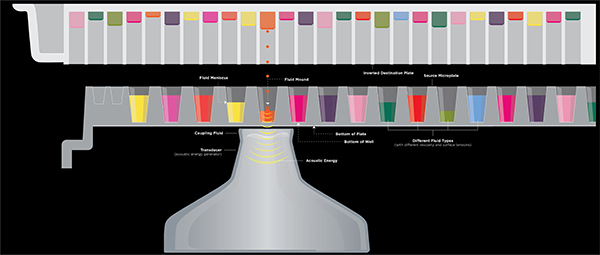MOVING LIQUIDS with SOUND
Delivering Precise, Accurate, and Cost-efficient Liquid Transfers
The Echo Liquid Handler has revolutionized liquid handling with an innovative technology that produces faster and more accurate results than traditional pipetting methods. Whether you are involved in drug discovery, compound management, genomics research, synthetic biology, proteomics, functional screening, or other research applications, you can do better science and save money with the Echo acoustic droplet ejection (ADE) technology.
Powerful but gentle in its approach, ADE drives Echo Liquid Handlers. It focuses ultrasonic acoustic energy at the meniscus of a fluid sample to eject small droplets of liquid from wells and position them precisely onto a surface suspended above the ejection point.
Echo Acoustic Liquid Handling
The Echo Liquid Handler revolutionizes liquid handling by using acoustic energy. Sound waves eject precisely sized droplets from a source onto a microplate, slide or other surface suspended above the source. The Echo Liquid Handler can transfer as many as 750,000 samples a day to 384-, 1536-, and 3456-well plates, slides, and microfluidic devices, without touching the samples. This groundbreaking technology benefits laboratory workflows and operations of all sizes.
DYNAMIC FLUID ANALYSIS
On-the-Fly Adjustments to Changing Fluid Properties
Dynamic Fluid Analysis enables Echo Liquid Handlers to adapt easily to different types of fluids. This patented software algorithm:
- Adjusts acoustic energy requirements in real time without operator intervention
- Eliminates manual calibration
- Ensures accurate, precise fluid transfers
- Increases the range of fluids transferred by acoustic energy
The Echo Liquid Handler uses Dynamic Fluid Analysis capabilities to simplify experimental setup and enables a higher degree of experimental and workflow flexibility.
Key Benefits
- No need to calibrate the instrument in advance — the Echo Liquid Handler determines transfer parameters for each reagent at runtime.
- Larger-volume transfers are accomplished by transferring the same drop size repeatedly—there’s no requirement to scale with volume.
- Dynamic Fluid Analysis is an active process—and therefore less sensitive to reagent changes than a single calibration point—so downstream experimental data can be more consistent.
- Dynamic Fluid Analysis determines the appropriate transfer parameters on a well-by-well basis, and thus works with more complex reagent sets or inconsistent reagents.
Background on Fluid Transfer and Liquid Handlers
Fluid transfer methods are impacted by two key fluid properties: surface tension (the way fluid at an interface interacts with its surroundings) and viscosity (the resistance of fluid to move). Most liquid handlers are passive and require operators to determine how to overcome surface tension and viscosity for their specific reagents, putting the burden on them to calibrate the instrument to transfer that reagent.
This burden is substantial, because calibrations:
- Must be verified and repeated on every instrument that is required to transfer that reagent.
- Usually work over only a limited volume range.
- May drift with the age of the liquid handler as mechanical components wear down.
- Are only an approximation; calibrations against inconsistent reagents (e.g., cell lysates in a screen, or high-viscosity reagents) may not transfer accurately and precisely, which may lead to data errors downstream.
- Cannot be developed for certain types of reagents on multichannel liquid handlers (e.g., commercially available crystallography reagents, by design, consist of reagents of varying viscosity and surface tension properties).
Dynamic Fluid Analysis Technology Improves Liquid Handling
Echo Liquid Handlers use sound energy to transfer reagents in drop increments on a 2.5 or 25 nL scale (instrument dependent). All models incorporate a transducer, which converts electrical energy to sound energy to accomplish the drop transfer. The transfer process can be explained in two broad steps:

SURVEY: The Echo Liquid Handler determines fluid height and properties in the source wells. The transducer (acoustic energy generator) sends soft energy pings into each well and receives the reflections (or echoes) returned from three interfaces:
- The bottom of the source microplate
- The bottom of the well
- The fluid meniscus
TRANSFER: The transducer returns to the first transfer point and sends a larger energy burst to accomplish the transfer in discrete, consistent droplets. Key to this process is that the transducer interfaces with one well at a time. This affords the capability to perfect transfer for each source well. General information on the fluid type provided by the operator (e.g., DMSO, buffer, reagent containing glycerol, etc.) narrows the transfer parameters.
Dynamic Fluid Analysis uses a power-adjustment ramping process to slowly increase the energy from survey power level to transfer power levels. By listening to subsequent echoes, the Echo Liquid Handler can determine the appropriate power level required for transfer from each source well. This process is accomplished in milliseconds and requires no operator intervention.
Source: https://www.mybeckman.vn/liquid-handlers/echo-acoustic-technology
Our products: https://minhkhang.com.vn/en/product-category/biological-technology/biological-analysis-instrument/automated-sample-preparation/acoustic-liquid-handlers/



 VI
VI